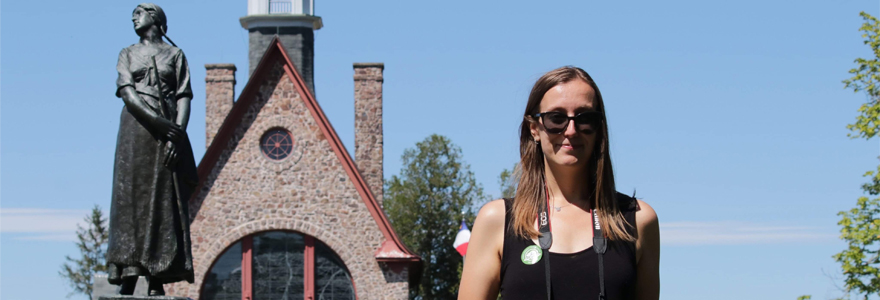News and Updates
Contact
Faculty of Social Science
Social Science Centre
Room 9438
Western University
T. 519-661-2053
F. 519-661-3868
E. social-science@uwo.ca
Highlighting the living history of museums

Erin Isaac at at Grand Prés - photo submitted; story by Rob Rombouts
Behind every museum display, there is a story. Erin Isaac wants to highlight those stories through her YouTube channel, Historia Nostra.
Isaac is completing her PhD in the Department of History at Western. While working at a museum in Saskatchewan, she became very interested in “how museum structures and decisions impact what you see, and how staff and guests impact how you interpret that space.”
Inspired by what she calls the ‘weird corners of YouTube’, including channels focusing on the history of amusement parks, she decided to start her own channel. Her videos show the decisions and work in creating and updating museums and heritage sites in North America.
Using videos allowed Isaac to show the exhibits and museums she is talking about, but it also presents its own difficulties. “The choice to do a YouTube channel has made my life a lot harder,” she said. “There are copyright issues in play at museums and with exhibits that wouldn’t be there with an audio format.”
While some may see museums as static institutions, many museums are continuously updating their approach to history and how they present it. This includes making exhibits more accessible or through online options, an approach spurred by the pandemic. It also includes a push to highlight more marginalized voices, and trying to incorporate more Indigenous content and engagement with Indigenous communities.
While Isaac knows her videos, and the changes highlighted in them, may spur debate, she does not generally engage with the conversation, unless there are attacks or problematic comments directed toward staff.
“Debates on the videos have often been along the lines of people taking information out of context,” said Isaac, noting this is more common when she presents information about U.S.-based museums.
“When people feel they have an attachment or personal connection to a museum or its subject, there is more pushback to what is being said,” she said. “I think the pushback is important for people to see that others are engaged and connected to this content, and it helps show the challenges museums are facing when they are making these changes.”
Isaac has noticed her own approach to the subject changing, including working with the museums to get access, and developing a better understanding of the kind of stories to be highlighted.
“I’ve gotten better at identifying elements of exhibits that are good or working, rather than just the bad parts or things that should be changed,” she said. She has also heard from museum staff who are pleased with the spotlight she is providing to their work and the decisions that go into displays. “Curators have appreciated being able to come out from behind the curtain.”
Isaac is not focused on going viral, but rather in presenting an academic approach to a wider audience.
“I’m a scholar, so it’s exciting to see people looking at the work,” she said. “When you have a few hundred people watching the video, it may be low for YouTube metrics but good for academic work”
Find Historia Nostra on Facebook, Instagram, Twitter and YouTube.

